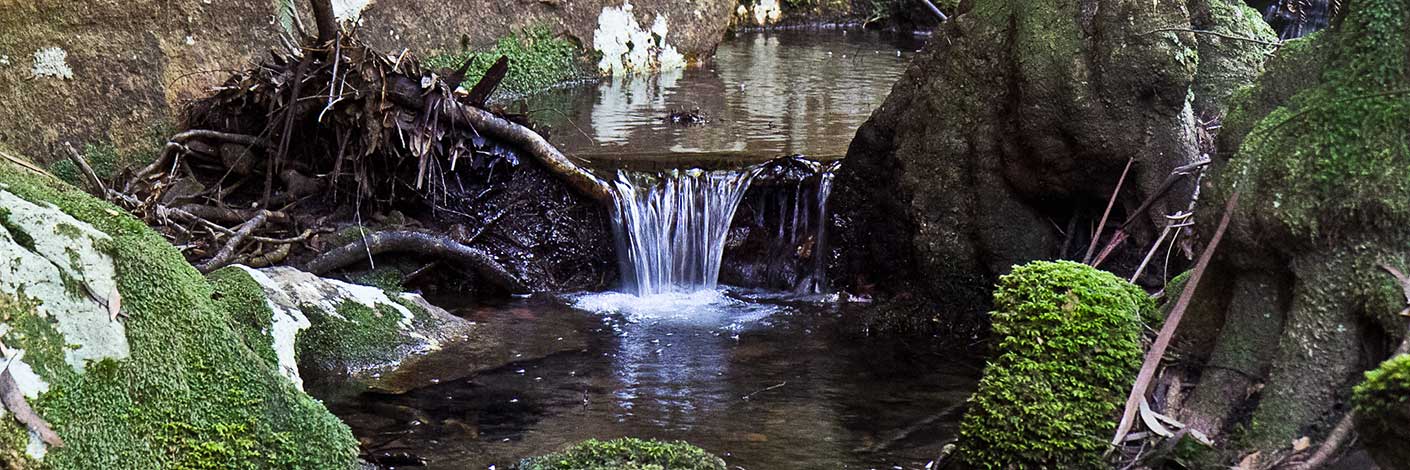Bush Explorers Encyclopaedia
17 Sisters
Is a string of pagodas stretching from 472 941 to 474 941. Located 1.5km south east of Goochs Crater. Named from a viewing point GR 465 928, when Ian Thorpe was leading a walk for SPAN Outdoors in 2006. The name lampooning the name, The Three Sisters.
84 Foot Lookout
Is located on top of the cliff edge at Hassans Walls Reserve, between Nellies Glen and Pavilion Gully and 90m west of the communication tower. Named by Keith Painter and Brian Fox on an investigative walk 6th September 2016. This unnamed old fenced lookout has 84 feet of meshed fencing. Lithgow Mercury 17th May 1935, p. 4. Records, “ and a start will be made next week on the fencing of 84ft. of a new look-out.”

Acoustic Chamber
Is located within Sunnyside Canyon. Peter Medbury first visited the canyon on 2 November 2008. Peter had contacted Dave Noble at the time and he told me (Peter) the canyon was named Sunnyside Canyon. It had been named Acoustic Canyon when first discovered (late 70s??) but it turned out the name had been used so it was renamed to Sunnyside Canyon. I’d have been surprised if the name hadn’t already been applied to that Chamber (but I could well be wrong). On a later bushwalk by the Bush Club Mike Keats track notes record, The famous hemispherical cave in the lower reaches was visited. Pacing it out, it has a diameter of about 24m, a height of about 15m including a domed ceiling. Droppings on the floor show evidence of an active roost for bats.
Adrenalin Creek
Flows in an approximate north to south direction for 6.5km, from the junction of Birds Rock Trail and Sunnyside Ridge Road to its confluence with Carne Creek. Contained in it's headwaters, is Cathedral Cave. Michael Keats recorded on 25th February 2013, "I have called this area, east of Firetrail No. 6 and the next ridge east, and questionably Firetrail No. 5, the Adrenalin Gorges of Carne Creek. The name is inspired by a complex terrain so stimulating and so beautiful it really gets the adrenalin flowing."
Adrenalin Head
Is the prominent headland located at the end of Firetrail No. 6, south of the Wolgan Pinnacle and between Endorphin Gully and Adrenalin Creek. It is characterised by massive vertical cliffs up to 116m high and partly negotiable benched ledges. The highest point of the headland is at GR 384 137.
Adrenalin Ledge
Is an incredible ledge, halfway below the cliff line overlooking Carne Creek. It extends for 1km. The midpoint is located 1km south east of the Wolgan Pinnacle, access via Sunnyside Ridge Road and Firetrail No. 6. So named by Yuri Bolotin on a Bush Club walk, 6th May 2013, in keeping with the name of the creek system to the east, Adrenalin Creek.
Adrenalin Ledge East
It also dawned on us that the ledge that had we had started walking on in the gully to the east was easily negotiable. Given that it is on the eastern side of Adrenalin Gully we decided to call it Adrenalin Ledge East. Bush Club walk 17th January 2014.
Adrenalin Slot
This slot is special and so it was that we agreed to call it Adrenalin Slot as it faces into, and connects with Adrenalin Creek. Bush Club walk 17th January 2014.
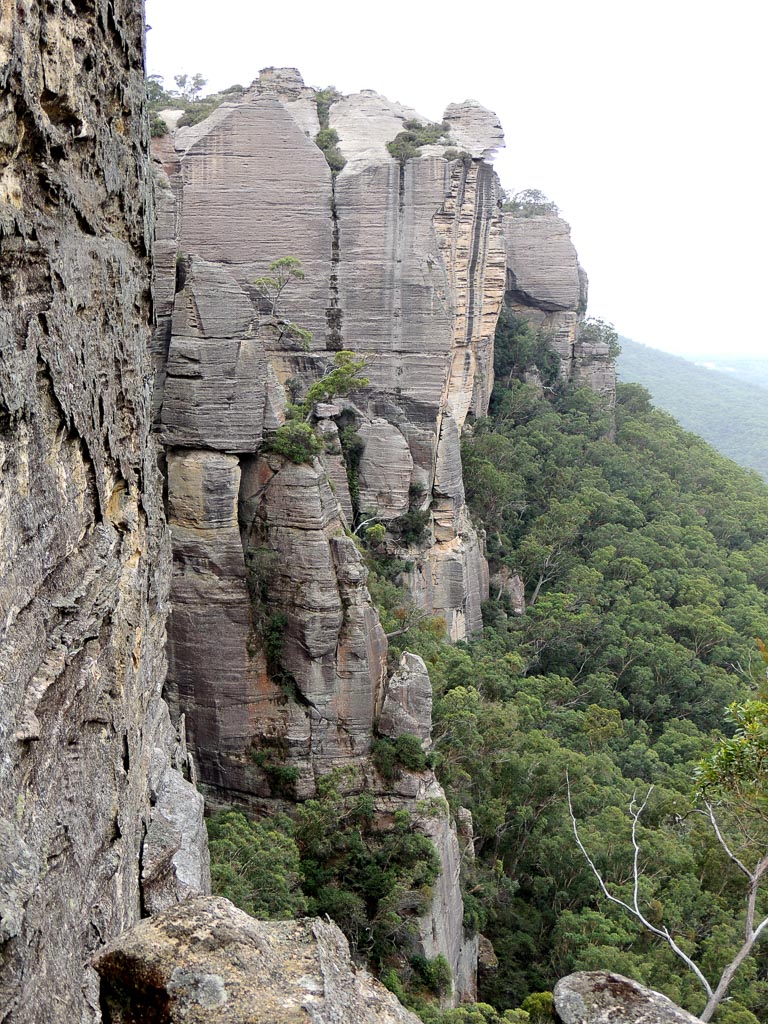
Airly *
Is the locality name, which encompasses Mount Airly, Airly Turret and what was the Town of Airly. Glen Alice Topo Map, GR 240 332. The earliest reference to this name is recorded in Annabella Boswell's Journal, March 1839. She records the name Elyor, Erly Flat.
James Galagher purchased 40ac in the area in 1852 and used the name Airly. His second house at this location, constructed in 1863, was named Airly House. James" grandson, Rupert, recalls originally the place was called Early Flat.
Airlie is the obsolete dialect form of "early". The word Airly is also the obsolete term for earthly or heavenly and had a mention in Norton's verse in 1652, "which bare up Erth with his Aierly migh."
Ref: Mayne, Dianne. Airly Newsletter 1898. Unpublished, 1980. Galagher,Rodney. The Galaghers of Airly and Port Macquarie, 2010.
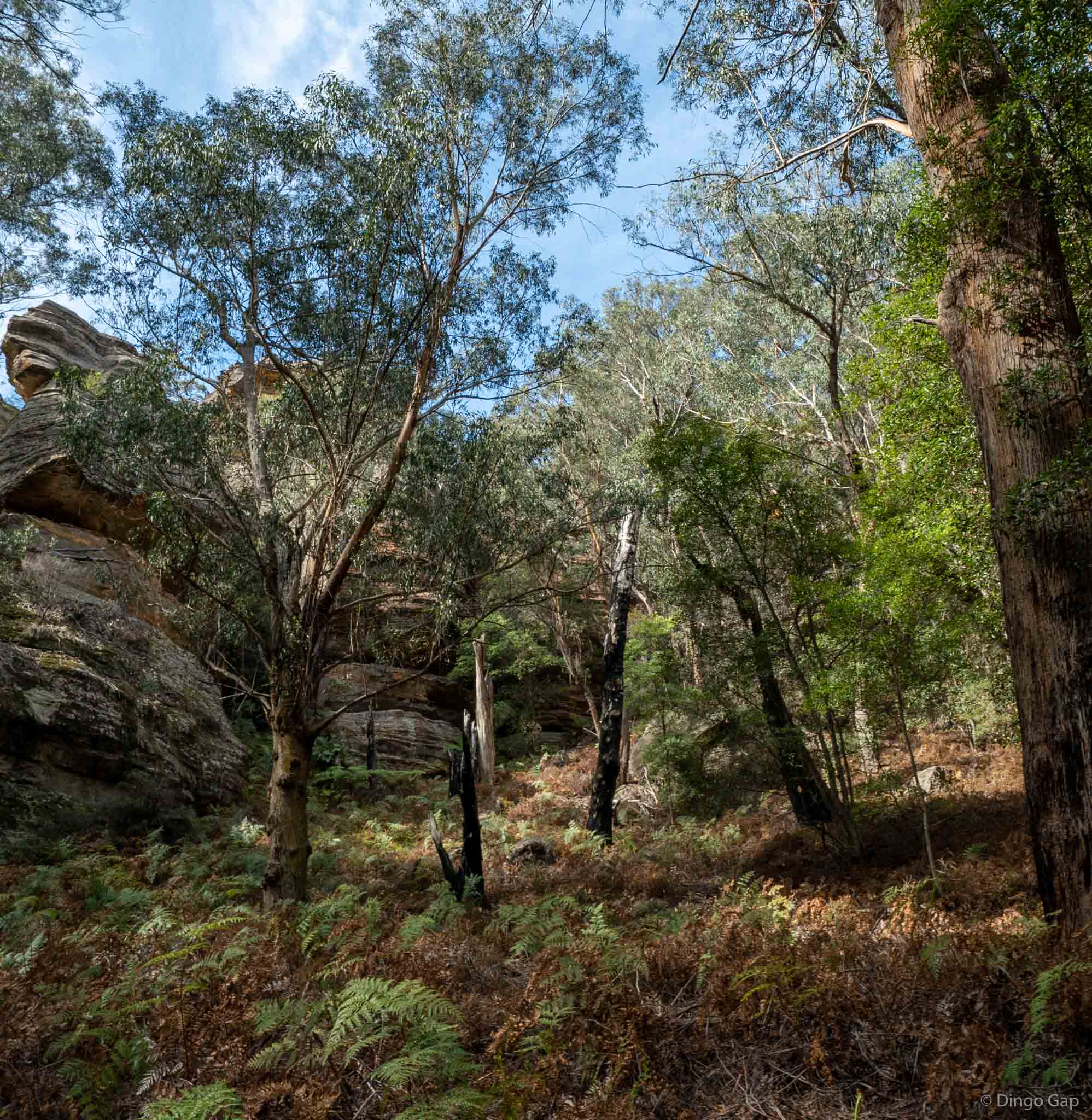
Airly Basin

Airly Canyon
Is a short canyon starting on Mount Airly and traversing east to Airly Village. Named by Peter Medbury who records,“The canyon can be traversed in either direction. A tape is required near the top. There are a couple off pools near the top of the canyon. There is an old mine adit under a large rock shelf, a small dam on top and associated water pipes apparently used to supply water to the miners”.

Airly Connector Slot
Is a natural 250m, gentle gradient passage between cliff lines of heights up to 20m. This slot access is an alternate means to using a section of the road from Rock Bottom, Airly Gap towards Mount Airly. The slot has a short tunnel section. Named by Michael Keats, Yuri Bolotin and Brian Fox on a Bush Club walk 23rd June 2017.
Airly Creek *
Is a non perennial stream rising 4.8km north east of Capertee. It flows generally south east for about 12km into Coco Creek. Airly Creek is shown on the map Parish of Bandamora, 1882.
Airly Creek Trail
Is a NPWS signed walking track. It is approximately 5km in length and is based on former property access roads. It commences on Glen Davis Road and follows a ridge south, crosses Airly Creek and terminates at the junction with Murdocks Creek Trail.
Airly Flat
Is located on the Castlereagh Highway just north of the town of Capertee.This old name was used to describe the location of James Galagher's property. Ref: Survey Plan 12.1496, dated 4th November 1852. Bathurst Free Press and Mining Journal, 2nd July 1853, p. 4; col. 1.
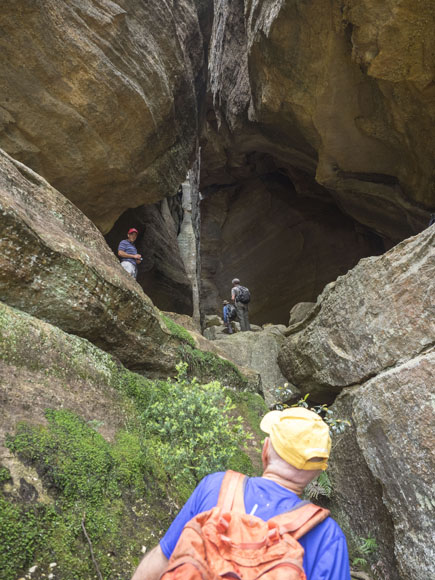
Airly Frustum
Is a hollowed out truncated cone or frustum.This glorious piece of architecture is some 20m in diameter. It is endowed with natural skylights and an internal water supply. At floor level colourful benched decks of red shale extend north and south; internally it is cluttered with fallen rocks like discarded furniture overturned as though someone left in haste. Located 340m due west of the communication tower at Airly. Named by John Fox on a Bush Club walk 16th November 2015.
Airly Gap
Is a saddle separating the catchments of Gap Creek and Malcolms Gully. It was also the original access to the Town of Airly. It is located approximately 1.2km from Glen Davis Road. Also known as Airly Gate.
Airly Mountain Trail
Has been signposted by the NPWS (erected 2014). This trail starts at the intersection of the TramwayTrail, near the property Rock Bottom, GR 240 335. The trail winds its way up Mount Airly and along the top of the plateau and then in a north east direction to approximately 235 342.
Airly Turret *
Is a rocky peak about 2km south east of Mount Airly. Airly Turret is shown on the map Parish of Airly, 1st edition, 1884.
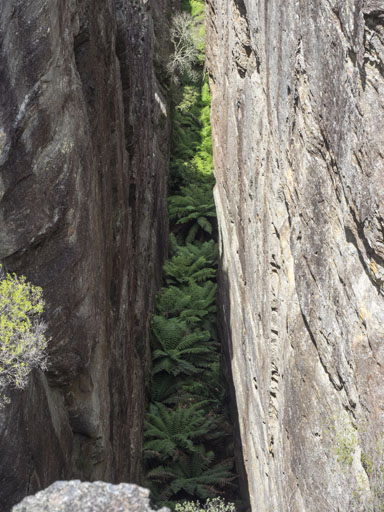
Airly Turret Slot
Located 240m due west of the communication tower at Airly is a major feature being some 3-5m wide, 45m deep and 100m in length, however traceable over a distance of more than 400m from Airly Turret in the south to a non negotiable 30m north point on the cliff line. The floor of this slot is full of the Soft Tree Ferns, Dicksonia antarctica. Named by Yuri Bolotin and Michael Keats on a Bush Club walk 16th November 2015.
Alcatraz
Is a descriptive name based on the notorious prison in the USA. This prominent isolated impregnable monolith above 1000m is located south west of Woolpack Rock, and the southern extremity, between Hughes Defile and Woolpack Gap. The name was created by the original three who proposed the Gardens of Stone National Park, Rodney Falconer, David Blackwell and Dr Haydn Washington, in November 1984.
On 28th February 2017 Haydn clarified the naming of Alcatraz, “...with Alcatraz we were looking along the divide and saw past Woolpack Rock and that creek what seemed a virtually impregnable fortress of cliffs, so called it Alcatraz, and I recall it was interesting getting onto it. So it was the whole pagoda cluster that led me to give it that name.”
Alcibiades Rift
A 20m slot near the western end of Zeus Minor formed by a section of cliff line having broken off and fallen away to now give access from the western to eastern side of Zeus Minor. Alcibiades was an Athenian politician and general in the Peloponnesian War.After the death of his father in 447, he was brought up by Pericles and Pericles's brother Ariphron. He was notable for changing sides. Named on a Bush Club walk, 25th July 2011 by Michael Keats.
Alloway
Was named after the Alloway in Ayrshire, Scotland. Captain John Piper was born in Maybole, Ayrshire. Ref: Eldershaw, M. Bernard, The Life and Times of Captain John Piper, 1973, p. 126.
Alloway Creek *
Is shown on the Parish of Coco map, 1883. It is a non perennial stream rising on the south west side of Mount Alloway. It flows generally south east and north, north east for about 6km into Airly Creek. The name Alloway Bank was the property name of Captain John Piper (1773-1851), whose main residence was in Bathurst. He also held grazing rights in this area of Alloway Creek. Fry, Ken. Beyond the Barrier, 1993, p. 118, records Captain John Piper "excelled in hospitality and social graces. His door was always open to guests and visitors of his class." John Piper was an early Magistrate and hence held in high honour and esteem.
Alois Creek
Has its headwaters on the Great Dividing Range 4km south east of Cullen Bullen. It flows south, then east for 3.6km into the Coxs River. Named by Michael Keats on a Bush Club walk on 19th October 2012. Named after Alois Joseph Neubeck (1821-1904). When he and his wife Clara emigrated from Germany to Australia in 1855, they moved to Wallerawang and Alois was employed by James Walker. In 1862, the family moved to Blackmans Flat (near the present day Mount Piper Power Station), where he set up a business as a blacksmith, and also provided a staging area for Cobb and Co.

Alois Spur
Is located to the east of Hermits Spur and is conjoined to it at its northern extremity, GR 272 083. Named by Michael Keats on a Bush Club walk, 19th October 2012. Named after Alois Joseph Neubeck (1821-1904).This spur extends south for about 1.8km.
Altar Room
Yuri Bolotin devised the name, the Altar Room, after his emotional experience of visiting the place on 10th September 2011 on a walk led by Tom Brennan. He did not share his thoughts with others in the party at that time but returned to that place a few months after.The Altar Room is a pass about 250m in overall length joining Little Capertee Creek to the crest dividing it from the Canobla Creek. The ascent from bottom to top is about 350m. Altar Room, previous name by Dave Noble 2002, Suspira Canyon, The Three Mothers by E.Varelli.
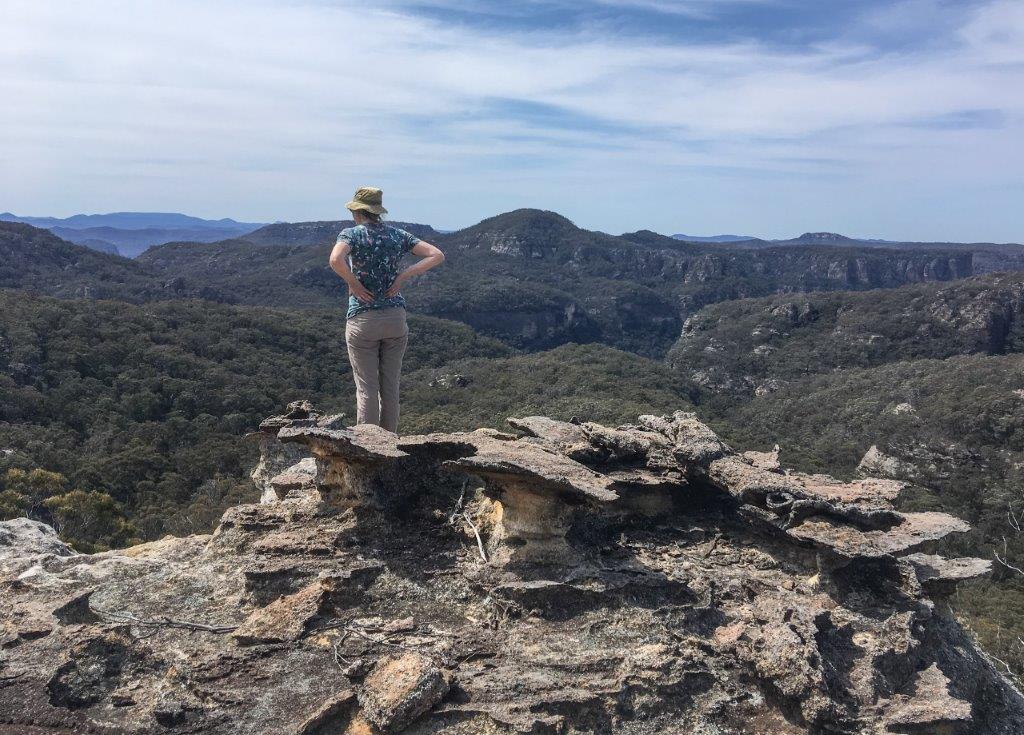
Altar Room Panorama
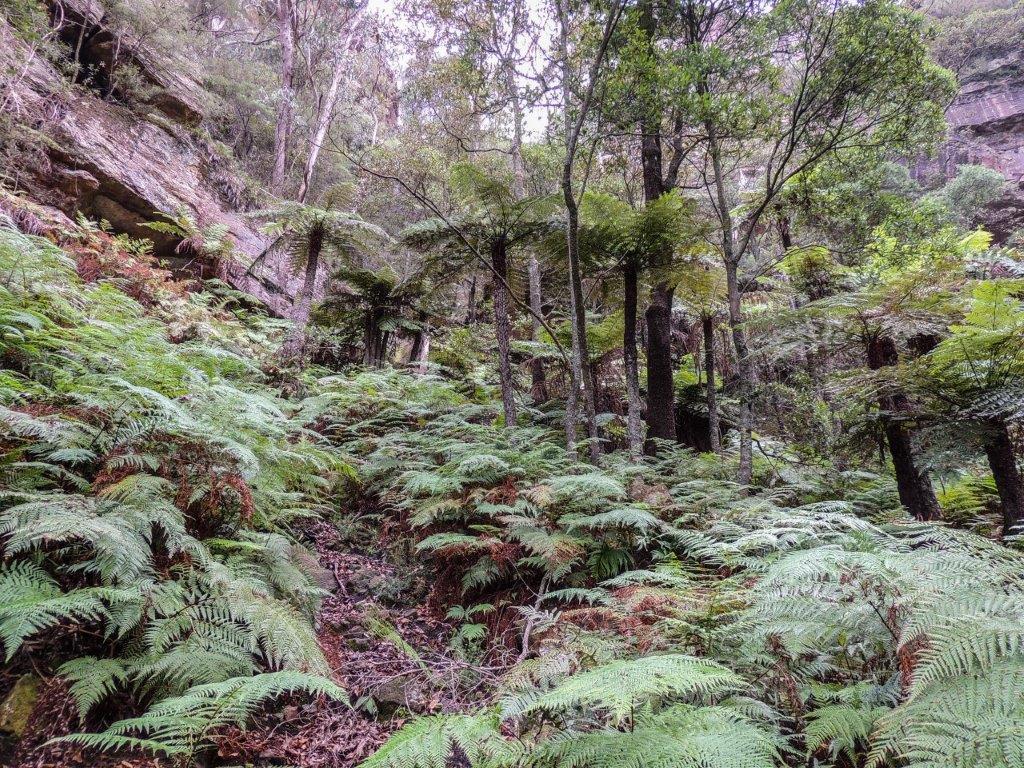
Amphitheatres Pass
Is a pass which breaches the cliff line between Woolpack Gap and Collett Gap giving access to the Wolgan Capertee Divide. Through not as easy as the other passes in this area, a narrow steep slot at the top on the western side of the amphitheatre gives final access to the divide. The amphitheatres is a descriptive name adopted for the shape of this tree fern laden area. Named by Yuri Bolotin and Brian Fox on a Bush Club walk 16th March 2018.
Angels Rest
Is a 360 degree view atop a pagoda with extensive views into the incised convolutions of the Bungleboori Creek, where each twist and turn is embellished with pagodas, cliffs, caves and decorated walls, while deep dark patches indicate the presence of hidden canyon sections. Located 2.8km north east of Bald Trig Station and accessed via the firetrail towards Dumbano Creek. This name was coined by Michael Keats on a bush walk, 30th April 2012, to coincide with the named feature to the east, Holts Heaven.
Angels Rest Falls
Is located on a southern tributary of Bungleboori Creek, 2.9km north east of Bald Trig. This perennial waterfall has a drop of about 30m. After heavy rain it is spectacular, flowing into a ravine of tree ferns. Named by Michael Keats on a Bush Club walk 12th January 2015 as it is in close proximity to the pagoda known as Angels Rest.
Angels Window
Was named along with the heavenly theme of other features in this area. This single pagoda on the northern side of Bungleboori Creek gives impressive 180 degree views of a pagoda studded landscape, particularly south east towards Holts Heaven. Named by Brian Fox,Yuri Bolotin and Michael Keats on a Bush Club walk, 21st May 2012.
Angry Man Lookout
Is a lookout point from where a giant caricature of a face was spotted high on the cliff face (looking east down Capertee Creek) by Marion Davies. Viewed from a rocky pinnacle above Capertee Creek along Newnes Balcony East. Named by Yuri Bolotin and Brian Fox on a Bush Club walk, 1st November 2013.
Angus Place *
Is a locality about 4km south of Wolgan Gap and 4km north, north east of Lidsdale. Angus is another Scottish name within this region. Airlie in Scotland is located within the County of Angus. Ref: Gazetteer of British Place Names. James Walker was one of the original land owners holding a number of portions of land in this vicinity. He emigrated from Perth, Scotland in 1823. Angus is a locality in close proximity to Perth, Scotland. The Survey Plan of Portions 71-73, dated 28th August 1930, showing one acre blocks, has the pencilled text, Angus Place. Ref: Survey Plan C2803.1507.
Angus Place Trail
Is a NPWS signed walking track. It is approximately 5km in length, commencing on the Wolgan Road at Angus Place, GR 299 056, and terminating at a junction with the Beecroft Firetrail, GR 321 030. Also see Dando's Firetrail
Annie Rowan Creek *
Is a perennial stream rising about 2km south east of Mount Cameron. It flows generally north for about 9km into the Wolgan River about 1.5km south west of Mount Morgan. It first appeared on the map Parish of Barton, 1884. At the junction of the Wolgan River and Annie Rowan Creek is the feature known as (see) Binnings Hole. It is most likely Annie Rowan was the sister of Walter Rowan who died on 3rd November 1858, aged 40. Rowans Hole was named after Walter Rowan. Ref: NSW BDM Rego No. 5413/1858 and Old Catholic Cemetery, North Street, Nowra records.
Ant Hill
Is located midway along Ant Hill Ridge at 1025m. Named by Peter Fox, National Parks Association bushwalker, 1995-1998.
Ant Hill Ridge
Generally trends north south off Girdwood Ridge. On the eastern side is the feature known as Holts Heaven. The northern end of the fire trail on this ridge leads to the headwaters of Dumbano Creek.
Anzac Ridge
Refers to the spur line 300m in length extending south of King Georges Head towards the Great Western Highway, within Hassans Walls Reserve, Lithgow. The Democrat, 1st October 1915, p. 6, records the progress association, entry,“new track….to King George’s Head Rock, and thence to a small ridge overlooking the Bathurst-road, which was recently named Anzac Ridge." So named after the Australian and New Zealand troops landing at Anzac Cove, Gallipoli, 25th April 1915.
Apex Lookout
Is located in the vicinity of Bracey Trig Station. Access via the southern end of Bridge Street, Lithgow. The Apex Club of Lithgow developed the area in 1952-53. The Lithgow Mercury, 6th July 1953, p. 2, records, “ During the week-end, under the supervision of Mr. Glen Edgar, a working bee formed a track, from the Apex Lookout, the furthest point which could be previously reached by vehicles, to Bracey's Lookout so that material could be taken to the proposed site of the lookout shelter shed."
Apex Point
Is the point of land in the vicinity of Bracey Trig Station. Access via the southern end of Bridge Street, Lithgow. The Lithgow Mercury, 28th October 1952, p. 2 and 7th July 1954, p. 3, records,“A preliminary survey, conducted by a team of five members of Lithgow Apex, on Saturday pegged out portion of a proposed easy access route from the junction of Bridge and Esk streets, around Apex Point, to Bracey Lookout and Hassans Walls Lookout."
Apple Tree Point
Is the end of the ridge line above Annie Rowan Creek, 3.4km north, north east of Mount Cameron. Local usage name prior to 1980s. Ref: correspondence with Danny Whitty, 3rd July 2010.
Aragorn Slot
Is a beautiful slot crowned with stunning pagoda formations on the top. Aragorn is the main protagonist of Lord of the Rings who was instrumental in the quest against the forces of evil. Named by Yuri Bolotin on a Bush Club walk on 15th August 2013, in keeping with his Lord of the Rings themed names in this area. Located 1.2km north east of InvincibleTrig Station.
Ariadne Needles
Are two slots within the Koopartoo Mesa complex. Located 1.9km west of the Wolgan River and Zobels Gully junction. Named by Yuri Bolotin on a bushwalk 22 August 2017 who recorded,“two thin parallel slots, close to one another, about 130m and 80m long, both negotiable. You can take one to go up for incredible views from the top, and another one to come down. I will call them Ariadne Needles.”The name is in keeping with the mythology theme names related to the Minotaur, Ariadne Thread, etc.
Ariadne Thread
Is an amazing slot that allows walking access from the northern section of Koopartoo Mesa down into the eastern end of Minotaur Lair. Located 1.5km near due west of the Wolgan River / Zobels Gully junction. This cliff lined slot drops 80m and has an overall length of 200m. It would rank as one of the most spectacular descents in the Wollemi National Park. A tape is recommended in at least two locations for extra caution when traversing this slot. Jointly named by Yuri Bolotin, Michael Keats and Brian Fox on a Bush Club walk on 10th October 2016. The Greek myth of the Labyrinth and the Minotaur, where Ariadne gave Theseus a ball of red thread to follow out of the Minotaur Lair, provided us with an ancient insight on how to find our way through the slot. A 10 m high stone statue of Ariadne stands at the bottom part of the slot.
Arwens Pathway
Is located on the Ben Bullen Range, 2.7km east, south east of Cullen Bullen. This is a beautiful long overhang, decorated with ornate weathering and multi coloured layers. The overhang connects the Hall of Celebrian to the cliff line that rises to the Hall of Elrond. Hall of Arwen is located at GR 268 104 at the start of Arwens Pathway. Named by Yuri Bolotin on a Bush Club walk, 28th June 2012. Arwen is the daughter of Elrond and Celebrian and the future wife of Aragorn, the main hero of Lord of the Rings. Yuri has named several features in this area based on the fictional characters created by J. R. R Tolkien.
Ascension Point
Is the end of a small spur. In keeping with the heavenly themed features in this area, Yuri Bolotin named it on a Bush Club walk on 7th June 2012. Located above the northern side of Bungleboori Creek, 3.3km south, south east of the Two Trees Road and Waratah Ridge Road intersection. Other features in this area include Holts Heaven, Angels Window and Angels Rest.
Axehead Cave
Located above the upper reaches of Bungleboori Creek has a width below the drip line of about 17m. The depth is about 13m as is the height at the front. The most visible sign that it is a significant Aboriginal site is the solitary quite large red ochre hand and forearm stencil on the left hand side wall of the cave. The assessment of the stone which gives the cave its name, was that it looks like a basalt stone core that has been well worked judging by what appears to be numerous flake scars on its surface, but it could have once been an axe, given its form.
Baal Bone
Is a locality name. The first land grant of Cullen Bullen, (2000ac), was taken up by Robert Venour Dulhunty. His brother Lawrence Vance Dulhunty also took a large grant of land nearby. Robert Dulhunty was at one stage Commissioner of Disputed Land Claims in Queensland. Robert's son, Lawrence Joseph Edward Dulhunty, moved to Queensland, where he held extensive properties and was a well-respected and influential person. Dulhunty Plains and Dulhunty River were named after his family. The Dulhuntys took an interest in Aboriginal names of the Tambo area. An Aboriginal name for water and drink in the Norman River area was "baal". Locally, Baal Bone Gap is the only easy accessible means through the cliff line to the headwaters of the Baal Bone Creek and further south to the headwaters of the Coxs River. The coining of the word, "bone" as in "pointing the bone" adds direction via this gap. Ref: Indigenous word lists compiled by Smyth and Curr. Dulhunty Papers.The Brisbane Courier, 26th March 1881, p. 7. This aboriginal place according to Helen Riley, Wiradjuri Elder and Sharon Riley, Wiradjuri representative is for, Mens Business, and they would go no where near it. Ref: Oral history 3rd May 2016.
Baal Bone Creek *
Is a non perennial stream rising at Baal Bone Gap. It flows generally west, southwest for about 4km into Jews Creek.
Baal Bone Creek Trail
Is a NPWS signed trail named on the Ben Bullen topographic map with extensions to the south west being shown but not named on the Cullen Bullen topographic map. Taken at its greatest extension, it stretches from the Wolgan Road near Lambs Creek, GR 302 082,crossing through Gardiners Gap, passing east of the Baal Bone Colliery and terminating where it joins The Bicentennial National Trail about 1km south of Baal Bone Gap at GR 290 179.
Baal Bone Gap *
Was first shown on the map Parish of Ben Bullen, 1885. Baal Bone Gap is a saddle 1km west of Mount McLean. The Bicentennial National Trail crosses this gap.
Baal Bone Point *
Was also first shown on the same map as Baal Bone Gap. Baal Bone Point is the terminal point of land at northern end of the escarpment 2.5km south west of Pantoneys Crown.

Baal Sphinx Rock
It is an interesting rock that looks like a Sphinx. Located 2.25 km north north west of Baal Bone Gap; exactly halfway between Mercurys Boot and Baal Bone Point. If you walk along the ridge from Baal Bone Gap to Baal Bone Point, you won't miss this rock. Named on a bushwalk led by Paul Ma on 15 October 2020, with Harold Thompson, Freda Moxom and Nick Collins.
Bald Hill
is a descriptive name for the hill on which Bald Trig Station is positioned. One of the most extensive views in this region is seen from this vantage point. Bald Hill. The name was described in the Lithgow Mercury 12th March 1908, ….Bald Hills greet the sight. These hills are well named, for they are indeed bald. The name is shown on the map Mount Victoria to the Western County, 1914. The previous name for Bald Hill was Panoramic Hill. Named by Surveyor Robert Hoddle, 20th October 1823. Ref: Colville, Berres Hoddle. Robert Hoddle Pioneer Surveyor 1794-1881, 2004, p. 43. The former Wolgan Valley Railway skirted Bald Hill on the eastern side.
Bald Ridge
Was an older name for where the present Bald Hill and Bald Trig is located. Ref: The Lithgow Mercury 21st November 1902.
Bald Trig Station *
Is a trig station, at the elevation of 1180.70m, located on the ridge between the Bungleboori Creek to the north and north east and the Wollangambe River to the south and south east. The supporting stepped concrete base for this trig is over 2m high. The trig station was constructed in 1878-1879. Ref: Trig Summary Cards, Department of Lands, Bathurst.
Bandamora, Parish of *
A lands administrative division within the County of Roxburgh. It appears that the current spelling of the parish is incorrect as the earlier references show it spelt as Bandanora. The Sydney Gazette, 5th January 1832, p. 1 records land sale, 640 acres at Bandanora, about fifteen miles from Cullen Bullen. The property, Bandanora, is shown on the map NSW, The Surveys of the Australian Agricultural Company, 1833. A written history by William Corlis who lived at the property Bandanora from 1851 recalls the station was always called Bandanora, but he did not know the origin or meaning of the word. Ref: Jefferys, Bruce. The Story of Capertee, 1982, pp. 16-17.
Banksia Slot
Was so named by Brian Fox on a Bush Club walk 29th April 2016 as it contained four very fine healthy examples ofBanksia serrata. Located above the cliff line overlooking Canobla Creek and would be a pass through the cliffs to Canobla Gap Trail. Access via Newnes, Little Capertee Creek Camping Ground, Cathedral Canyon and the end of the northern spur.
Banner Drop Lookout
Is located on the western end of a short spur line off Gardiners Gap Trail within Ben Bullen State Forest 1.3km north, north west of Invincible Trig. So named after a protest in 2011 to stop open cut coal mining in this area. Name shown on Karen McLaughlin’s 2nd edition The Gardens of Stone Stage 2 Reserve Proposal Map, August 2016.
Barcoo Swamp
Is an old, disused name. Barcoo is an Aboriginal name meaning, "Ice on Water". Barcoo Swamp forms the headwaters of Deanes Creek. Barcoo Swamp is located on the north east side of the Glowworm Tunnel Road and Galah Mountain Road intersection. Cullen Bullen Topo Map, GR 438 111. Ref: Barcoo Swamp shown on Tramway from Wolgan to Clarence. Survey Plan M12435. Surveyed by John Haydon Cardew, Licensed Surveyor, 13th December1905. Stephens, Eric. Wolgan Railway Notebook, 1934-1937. Records, "Track to Barcoo Hut". The first land grant of Cullen Bullen (2000ac) was taken up by Robert Venour Dulhunty. His brother Lawrence Vance Dulhunty also took a large grant of land nearby. He was at one stage Commissioner of Disputed Land Claims in the Tambo, Barcoo district in Queensland. Robert's son Lawrence Joseph Edward Dulhunty, moved to Tambo, Queensland and it was here that some of his children were born. The Barcoo River runs past Tambo. Ref: Dulhunty Papers, The Brisbane Courier, 26th March 1881, p. 7. Carne, J E. Field Book, State Records, 2/663, 11th January 1906, records, "Barcoo Hut".
Baroque Spur
Is located on the western side of Deep Pass 1.3km south, south west of Deep Pass.Cliff lined on two sides, it contains the most intricate delicate erosion sculptures, incuding a window. So named by Michael Keats on a Bush Club walk, 24th August 2012. Michael chose the name, Baroque Spur, as the rocky features reminded him of the lavish architectural and artistic style of the baroque period.
Barton Creek *
Is a non perennial stream rising at McLeans Pass and Mount Jamison. It flows generally east by north for about 10km into the Wolgan River.
Barton Glen
Barton Pass
Is a natural inclined ramp that gives access from the base of the first cliff line to the top of the southern point, Chimera Point, and plateau which overlooks the Wolgan Valley, Donkey Mountain and the property, Penrose below. Named by Brian Fox on a Bush Club walk, 24th March 2016.
Barton Slot
Is located above the cliff line 1.5km north west of the Wolgan Road and Emirates intersection. This slot the about 200m long. In places it is 70m deep and varies in width from 50cm to 2m. Having a general gradient of 30 degrees except where a drop of 6m would entail a rope descent. Named on a Bush Club walk 28th August 2015 by Brian Fox, Yuri Bolotin and Michael Keats as it is located on one of the tributary creeks of Barton Creek.
Beagle Head
Is located 400m south east from the locked gate off Wolgan River Trail at Newnes. But with an elevation difference of 280m. This huge undercut part of the top cliff face jutting out over the Wolgan when viewed from the north east resembled the head of a Beagle dog. Named by Brian Fox on a bush walk 28th July 2014.
Beecroft Firetrail
Is a NPWS signed track about 8km long. It commences in Masons Lane north of Lidsdale at GR 296 045 and tracks generally east to join the Blackfellows Hand Trail close to the headwaters of the Wolgan River, GR 358 026. Beecroft Firetrail was from 1876 a shortcut for drovers moving their cattle and sheep from Bell to Ben Bullen via Gardiners Gap. Ref: Brown, Jim. Bent Backs, 1989, pp. 275-276. Henry Beecroft (1852-1935) first held a Conditional Purchase, 29th January 1876, then in 20th February 1881, 69ac. Later purchased Portion 100, Parish of Lidsdale, 40ac in1903; Portion 101, 84ac in 1908. Ref: Survey Plan 936.1507 and Certificate of Title Vol. 1560, Fol. 154. The land was passed down jointly to his son, Norman Edley Searl Beecroft (1894-1982), and in 1937 to another son Joseph GeorgeBeecroft (1878-1953) and his wife Annie May Beecroft (1876-1962) who held it until 1954. Joseph George Beecroft also held two Conditional Purchases at Mount Cameron from 1903-1947. Ref: Survey Plan C2098 and 2099.1507.
Beecroft Trig Station *
Was constructed by the Royal Australian Survey Corps in 1930. Ref: Lands Department Bathurst Trig Summary Cards. It is located at the elevation of 1025m on the southern side of Beecroft Firetrail, 2.5km north north east of Lidsdale.
Bell *
Is the locality on the north west extremity of the Grose Valley where the Darling Causeway joins Bells Line of Road. The railway station was originally named as Mount Wilson in May 1875 as it was here that travellers got off the train to continue their journey by horse and buggy to Mount Wilson. The name was changed to Bell Railway Station on the 1st May 1889, so named after Archibald Bell. The locality also taking on this name by default.There was a surveyed but unformed street in Newnes named Bell Street as well as seven families with the surname, Bell, appearing on the electoral roll as living in Newnes between 1906 -1922.
Bells Grotto
A beautiful Tree Fern filled grotto, is part of Tunnel Creek and is located on the southern side of the Glowworm Tunnel. This grotto by passes the tunnel. It was also referred to as Penrose Gorge. Eardley, G H. and Stephens, E M. The Shale Railways of NSW, 1974, p. 136, record, "The more hardy adventurous passengers left the train during the watering operation and walked the narrow footpath through the beautiful Bells Grotto." Ref: Deane, Henry. The Wolgan Valley Railway - Its Construction, 1910, reproduced by the Australian Railway Historical Society, 1979, p. 13, shows a map with Bells Grotto.
Bells Line of Road
Archibald Bell made a successful attempt of finding a passage from the Hawkesbury River to the Coxs River in September 1823. Surveyor Robert Hoddle was dispatched by Surveyor General John Oxley to survey this line just one month later, in October 1823. The name was referred to as Bell's Road, Ref: Government Notice, The Sydney Gazette and New South Wales Advertiser, 4th June 1829, p. 3. However, later the name was known as Bells Line of Road, Ref: Land sale advertisement in The Sydney Monitor, 18th June 1838, p. 3. The Lithgow Topo Map shows two sections of the Old Bells Line of Road. From Clarence to the junction of Glowworm Tunnel Road, and a small section of named road from Bungleboori Camping Ground in what is now known as Blackfellows Hand Trail. This was so named as it was part of Robert Hoddle's survey of Bell's Line, even though Archibald Bell did not traverse this area.
Ben Bullen *
Is a village located about 9km north of Cullen Bullen and 21km north by west of Wallerawang. Its boundaries are within the Lithgow Council administrative area. On John Lang's second visit across the Blue Mountains in 1834, he recorded stopping at the property,Ben Bullen, owned by Thomas Cadell, J. P., who with his family had arrived from Sydney in 1832. Ref: Lang, John Dunmore. An Historical and Statistical Account of New South Wales, 1875, pp. 218-221. The Sydney Gazette, 3rd August 1844, p. 3, records a boiling down establishment for the production of tallow from sheep at Ben Bullen. The NSW Geographical Names Board records Ben Bullen as an Aboriginal derived word. Two meanings have been given: high, quiet place and Lyrebird. Endacott, Sydney J. Australian Aboriginal Words and Place Names, 1961, p. 11.
Ben Bullen Creek *
Is a watercourse rising about 3km west of Wolgan Gap Trig Station. It flows generally north north west for about 6.5km into Jews Creek.
Ben Bullen Pillars
Are two very special prominent pagodas which can be seen from the Wolgan Road when passing through Angus Place. Both are subject to underground coal mining and one has a massive 45 degree split through it. Name given to them by Michael Keats and Brian Fox on a Bush Club walk, 21st December 2011.
Ben Bullen Railway Station *
Opened on 15th May 1882 and closed on 1st June 1974. The Ben Bullen public school opened in January 1878 and closed in December 1949. Ben Bullen Post Office opened 1st November 1889, closed 6th March 1965.
Ben Bullen Range *
Extends from the Great Dividing Range, 2.6km south west of Gardiners Gap. It trends generally north west for about 5km and finishes about 1km south east of Kirbys Hill. It was first shown on the Survey Plan 58.14996, dated 5th October 1853.
Ben Bullen State Forest *
Is located in the Bathurst Forestry District. It has an area of approximately 19,220 acres (7,778ha). Ben Bullen State Forest was dedicated on 20th May 1938.
Benbys Pinch *
Is a steep section of the old road way on the south side of the Wolgan River about 1km east of the Village of Newnes. Earliest map reference, Surveyor Edgar Harris on his survey of Wolgan River, October 1890. Ref: Survey Plan Misc. 111. Oe. R. One possible origin of the name is in recognition of William Benby. He arrived in Sydney from Brisbane on the steam ship Governor Blackall on 2nd June 1882. Another plausible suggestion is that the name was originally spelt incorrectly and that instead of Benbys it should have been Bendys Pinch as this pinch of land (tight constriction) is located where the Wolgan River takes a right hand turn from generally flowing south to north to west to east. This common descriptive name also fits with the common generic name of the named pinch further downstream, Devils Pinch.
Big Bell
Is a large bell shaped pagoda near the end of Point Cameron. Named by Dr Haydn Washington. Ref: Correspondence with Haydn Washington, 30th May 2010.
Big Foot Canyon
Was discovered by Ted Hartley on a Kameruka Bushwalking Club trip in 1977. It is located on the southern side of Island Mountain and accessed via Zobels Gully and Telephone Pass. It is a moderate grade three canyon with deep wades but no swims. It discharges into Deanes Creek.
Bindu
Is an overhang on the upper reaches of Kangaroo Corner Creek on the property Glastonbell. It is an old camping/ picnic site with old billies and mugs. GR withheld due to it being on private property.
Binnings Gap
Described by Surveyor, Joseph Carne, c. 1901, “as a well worn track that leads to a pass through the lower cliff line at a break to the right of the main gully.” Andy Macqueen, Wayfaring in Wollemi. pp 33-34 plus map reports, “The pass is steep and exposed. Above the pass the track appears to sidle for 140m until it intersects with the creek. It continues up the left hand side for 300m. The section from the creek to the small gully, although overgrown, was once laboriously benched and cleared of boulders and rocks.”
Binnings Hole
Is to be found at the junction of Annie Rowan Creek and the Wolgan River. It is first shown on Carne, Joseph. Geological Map of the Capertee and Wolgan Valleys, 1901. Carne, Joseph. Geology and Mineral Resources of the Western Coalfield,1908, p. 95. Alexander Binning (c1810-1863), a stonemason by trade, was a sub-inspector in charge of convicts working on Victoria Pass in the 1830s; he constructed Glasgow Arms Inn at Bowenfels and designed St Bernard's Church, Hartley, c1843. Ref: Cuneo, William Rev. Hunters of God, 1979, p. 26. Morgan, MacLeod. A short history of the Wolgan Valley, 1959. Jenkins, Yvonne. Bowenfels, 2008, p. 28. Survey Plan 491.691. Plan of 2 Portions applied for to purchase (Bowenfels), dated 1838. Alexander Binning also constructed Eskbank House, Bennett Street, Lithgow, in 1842, for Thomas Brown. This building is now a museum. It is most likely that Binnings Hole was named by Thomas Brown who had a selection of 80 to 90 acres there prior to 1899. Ref: Bathurst Free Press and Mining Journal, 28th April 1899, p. 3. Also see Rowans Hole, for geological description of the term 'Hole'.
Binnings Hole Neck
Is a 230m high basalt hill named by Joseph Carne, 27 October 1904, In his ‘Geology and Mineral Resources of the Western Coalfield, 1908,’ Carne writes “on south bank of Wolgan River, within the channel gorge. Apex at foot of southern escarpment of Hawkesbury Sandstone cliffs, extending thence to the river bank as a narrow, steeply falling ridge. Contacts well developed. Small channel down western slope exposing excellent sections of tuffs and agglomerates, GR 539 237. Ridge formed of olivine basalt. Patch of Coal Measure shales caught up in centre”.
Birds Cave No. 2
See Birds Caves
Refer to 3 caves along Birds Rock Creek. GR 402 083. The first and most significant is approximately 18m wide, 12m deep and 6m high with flat foor. The other two caves are located at GR 409 086, dimensions 25m wide, 10m deep and 10m high and at GR 410 086 a cave that is about 30m long and is effectively a two storey cave. It is proposed to name these caves Birds Caves after brothers James and Richard Bird. It is their names which was given to Bird Rock Trig. Station. Named by Yuri Bolotin and Michael Keats on a Bush Club walk 27th December 2013.
Birds Caves
Birds Caves No. 3
See Birds Caves
Refers to 3 caves along Birds Rock Creek. GR 402 083. The first and most significant is approximately 18m wide, 12m deep and 6m high with flat foor. The other two caves are located at GR 409 086, dimensions 25m wide, 10m deep and 10m high and at GR 410 086 a cave that is about 30m long and is effectively a two storey cave. It is proposed to name these caves Birds Caves after brothers James and Richard Bird. It is their names which was given to Bird Rock Trig. Station. Named by Yuri Bolotin and Michael Keats on a Bush Club walk 27th December 2013.
Birds Rock Creek
Is located within Birds Rock Flora Reserve. Having its headwaters off the eastern side of Birds Rock Trig Station, it flows generally east for 4.5km into CarneCreek. James (Jim) Lancelot Bird (1895-1978) and his brother Richard Edward (Bert) Bertrum Bird (1891-1961) during the 1920s used horse teams to log the area on top of Newnes Plateau. Jim also worked for the surveyor Lieutenant Colonel Clews when Birds Rock Trig Station was constructed in 1930 by the Royal Australian Survey Corps. Ref: Joe Bird (son of Jim) oral history to Brian Fox,15th June 2009. Lands Department Bathurst Trig Summary Cards. Survey Plan 2811 and 2812.1507 records James Lancelot Bird having a special lease of 339ac (137ha) between the years 1934 and 1961 within the Wolgan Valley.
Birds Rock Flora Reserve *
Is roughly elliptical in shape and lies to the east of Birds Rock Trig Station within Newnes State Forest. About 16km north, north east of Lithgow. Access is via Sunnyside Ridge Road and Birds Rock Trail. Birds Rock Flora Reserve has a total area of 415ha. Originally accepted for preservation in 1966 but not gazetted until 23rd September 1988. A number of Eucalyptus species are in this reserve, including the Blue Mountains Ash,Eucalyptus oreades. Ref: Birds Rock Flora Reserve No. 126; Newnes State Forest No. 748, Working Plan.
Birds Rock Lookout
Is a dramatic cliff edge lookout where the eastern end of Birds Rock Trail terminates less than 10m from a 150m drop into Carne Creek. Named by Brian Fox on a Bush Club walk, 10th October 2013. Access via Sunnyside Ridge Road.
Birds Rock Trig Station *
At the elevation of 1181m, is located about 6km south west of Deanes Siding and about 600m north, north east of the intersection of Sunnyside Ridge Road and Birds Rock Trail. T. S. No. 6278. Previously known as Sunnyside.
Birth Canal
Is a 180 degree bend below a spherical cavern within Kangaroo Corner Creek, 1.4km west of Bell. So named by a previous owner ofGlastonbell in the early 1990s.
